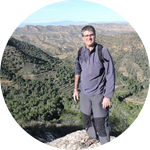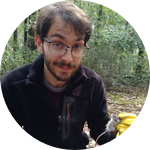About This Project
Distemper is a contagious frequently lethal disease that threatens many wild mammals, including endangered species. Disease presentation is very diverse, which might be due to the reported mutations in the viral proteins. We hypothesize that mutations in the proteins are related to differential binding to specific tissues in different species. This project will provide critical information for understanding the evolution and impact of distemper in wildlife.
Ask the Scientists
Join The DiscussionWhat is the context of this research?
Distemper is a potentially lethal viral disease of global distribution that affects many mammals, especially carnivores. Distemper has negatively impacted populations of endangered species such as black-footed ferrets and Santa Catalina island foxes and has the potential to spread to many other species. Reports of the disease in wildlife are common and there is an increasing number of different strains. The possible variation in clinical disease that may be presented by emerging strains has not been studied experimentally. Understanding the manner in which the virus impacts the body is crucial to managing the disease and susceptible populations. This could be through better management of populations or mitigation of human factors in disease transmission to naive populations.
What is the significance of this project?
Canine distemper virus (CDV) can cause severe, lethal disease in many species of wild carnivores, which can have effects in entire populations, as seen in the Serengeti lions. Despite the development of a vaccine for domestic dogs, the disease is far from controlled among wildlife populations, probably due to the existence of reservoirs of the disease. As predators, carnivores are an important regulator of ecosystems and maintaining a healthy population is needed to maintain ecological balance. This project will improve our understanding of the susceptibility of wildlife species to different CDV variants and the expected clinical presentation, allowing the development of better surveillance for early detection of outbreaks and policies for the protection of specific populations at risk.
What are the goals of the project?
We will examine eleven isolates of CDV from naturally occurring cases in the USA. After we have characterized the protein variations between the different isolates, we plan to study the ability of each isolate to bind the tissues of dog, raccoon and gray fox. We will use archived tissue samples from healthy individuals to quantify intensity of binding to each tissue and species and correlate this tissue binding to the clinical presentation of the disease and mutations in viral proteins. We hope to identify critical mutations of CDV that define viral tropism and will help us understand disease outbreaks and predict disease presentation in the wild. Once the results are published, they could ultimately help identify at risk populations and guide targeted management of populations.
Budget
The initial steps of this project are partially funded by the Karen C. Drayer Wildlife Health Center and the UC Davis Center for Companion Animal Health.
The costs of this project will be focused on the material costs for developing the tissue binding analysis. The requested funds will cover for cell culture and viral propagation, which allows to maintain and amplify infective CDV viral particles in our lab. We will also need funding for the expenses involved in the preparation of tissue slides and the reagents needed for viral detection after infecting the tissues.
Whole-slide imaging and tissue morphometry needed for the binding analysis will be provided by the Digital Microscopy and Whole Slide Imaging Laboratory. These charges would usually amount to $8,880, but the services will be provided by the Keel lab.
Endorsed by
 Project Timeline
Project Timeline
Starting Fall 2020, we will sequence key CDV genes to identify protein variations from distinct viral isolates. Before the end of November 2020, we will identify suitable candidate tissues from the School of Veterinary Medicine at UC Davis archives to use for our assays. During December 2020 and January 2021, we will perform the binding assay by exposing the selected tissues to different viral isolates and we will analyze the images to quantify viral binding during February 2021.
Sep 03, 2020
Project Launched
Nov 30, 2020
Identify candidate tissues for tissue binding assay
Nov 30, 2020
Analyze CDV protein variation
Jan 31, 2021
Tissue binding assay
Feb 28, 2021
Imaging and data analisis
Meet the Team
Arturo Oliver Guimerà
I am a PhD candidate in Integrative Pathobiology at the University of California, Davis. My research focuses in viral diseases pathogenesis and pathology of wildlife, trying to bring the molecular understanding of the diseases all the way to disease ecology.
I have always been fascinated by the mechanisms of disease, especially those caused by infectious agents. I obtained my DVM from the Autonomous University of Barcelona and a MSc in Wildlife Management at the University of Murcia. I have further complemented my formation in wildlife disease and pathology with different externships in Spain, UK and USA. I also completed a anatomic pathology internship with focus in zoological animals at the Barcelona Zoo and Autonomous University of Barcelona. I came to complete a PhD UC Davis with a Fulbright scholarship to improve even further my skills in the field under the supervision of Dr. Kevin Keel.
Kevin Keel
I guess I really began my education when I entered a Master's program in Widlife Biology. I have always been devoted to wildlife and the environment, so this was a natural place for me to end up. My thesis at the time focused on diseases of white-tailed deer, and I developed a deep fascination for the interactions of infectious agents and parasites with their respective hosts. Because I was so interested in the pathogenesis of these diseases, I entered veterinary school as a pathway to additional training in pathology. After completing a pathology residency and a PhD in microbiology, I went to work for the Southeastern Cooperative Wildlife Disease Study (SCWDS) in Athens, Georgia. That was an important job with wonderful constituents. However, I wanted to spend more time teaching, so after ten years at SCWDS I took a faculty position at UC Davis. I currently teach undergraduates, veterinary students, and pathology residents. I also receive necropsy and biopsy cases (particularly of nondomestic species) and I continue to conduct research in infectious diseases of wildlife.
The marriage of my interests in wildlife diseases and a concern for wild populations has led me along diverse pathways of study. However, a common theme has been the protection and optimal management of wild populations. Given the ever increasing anthropogenic changes in our environment, this has sometimes been a challenge. A critical step in effecting a positive change is knowledge about the problem. However, sharing that knowledge with the public so that they better understand the impacts of our (human) activities is just as important.
Project Backers
- 143Backers
- 120%Funded
- $4,818Total Donations
- $33.46Average Donation





